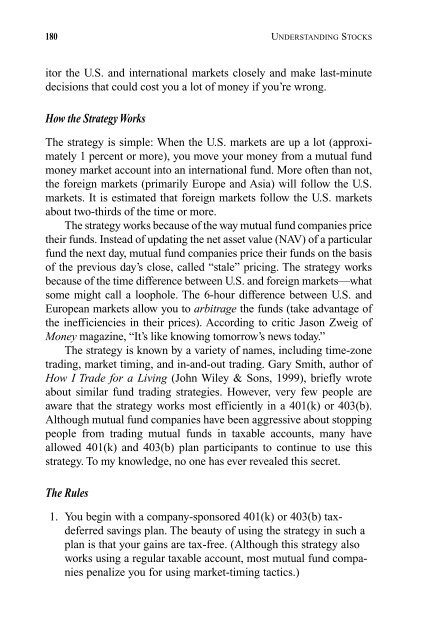Understanding Stocks
Understanding Stocks
Understanding Stocks
You also want an ePaper? Increase the reach of your titles
YUMPU automatically turns print PDFs into web optimized ePapers that Google loves.
180 UNDERSTANDING STOCKS<br />
itor the U.S. and international markets closely and make last-minute<br />
decisions that could cost you a lot of money if you’re wrong.<br />
How the Strategy Works<br />
The strategy is simple: When the U.S. markets are up a lot (approximately<br />
1 percent or more), you move your money from a mutual fund<br />
money market account into an international fund. More often than not,<br />
the foreign markets (primarily Europe and Asia) will follow the U.S.<br />
markets. It is estimated that foreign markets follow the U.S. markets<br />
about two-thirds of the time or more.<br />
The strategy works because of the way mutual fund companies price<br />
their funds. Instead of updating the net asset value (NAV) of a particular<br />
fund the next day, mutual fund companies price their funds on the basis<br />
of the previous day’s close, called “stale” pricing. The strategy works<br />
because of the time difference between U.S. and foreign markets—what<br />
some might call a loophole. The 6-hour difference between U.S. and<br />
European markets allow you to arbitrage the funds (take advantage of<br />
the inefficiencies in their prices). According to critic Jason Zweig of<br />
Money magazine, “It’s like knowing tomorrow’s news today.”<br />
The strategy is known by a variety of names, including time-zone<br />
trading, market timing, and in-and-out trading. Gary Smith, author of<br />
How I Trade for a Living (John Wiley & Sons, 1999), briefly wrote<br />
about similar fund trading strategies. However, very few people are<br />
aware that the strategy works most efficiently in a 401(k) or 403(b).<br />
Although mutual fund companies have been aggressive about stopping<br />
people from trading mutual funds in taxable accounts, many have<br />
allowed 401(k) and 403(b) plan participants to continue to use this<br />
strategy. To my knowledge, no one has ever revealed this secret.<br />
The Rules<br />
1. You begin with a company-sponsored 401(k) or 403(b) taxdeferred<br />
savings plan. The beauty of using the strategy in such a<br />
plan is that your gains are tax-free. (Although this strategy also<br />
works using a regular taxable account, most mutual fund companies<br />
penalize you for using market-timing tactics.)

















